Mercury
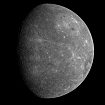
Mercury is the first planet from the Sun.
Mercury's elliptical orbit takes the small planet as close as 47 million kilometers (29 million miles) and as far as 70 million kilometers (43 million miles) from the Sun. If one could stand on the scorching surface of Mercury when it is at its closest approach, the Sun would appear almost three times as large as it does when viewed from Earth. Temperatures on Mercury's surface can reach 430 degrees Celsius (800 degrees Fahrenheit). Because the planet has no atmosphere to retain that heat, nighttime temperatures on the surface can drop to -170 degrees Celsius (-280 degrees Fahrenheit).
Because Mercury is so close to the Sun, it is hard to directly observe from Earth, except during twilight. Mercury makes an appearance indirectly, however 13 times each century, Earth observers can watch Mercury pass across the face of the Sun, an event called a transit. These rare transits fall within several days of May 8 and November 10. The first two transits of Mercury in the 21st century occured in May 2003 and November 2006. The next transit will occur on May 9, 2016.
Venus
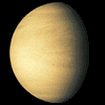
Venus is the second planet from the Sun.
At first glance, if Earth had a twin, it would be Venus. The two planets are similar in size, mass, composition, and distance from the Sun.
But there the similarities end. Venus has no ocean. Venus is covered by thick, rapidly spinning clouds that trap surface heat, creating a scorched greenhouse-like world with temperatures hot enough to melt lead and pressure so intense that standing on Venus would feel like the pressure felt 900 meters deep in Earth's oceans. These clouds reflect sunlight in addition to trapping heat. Because Venus reflects so much sunlight, it is usually the brightest planet in the night sky.
Radar images of the surface show wind streaks and sand dunes. Craters smaller than 1.5 to 2 kilometers (0.9 to 1.2 miles) across do not exist on Venus because small meteors burn up in the dense atmosphere before they reach the surface.
The Venusian year (orbital period) is about 225 Earth days long, while the planet's rotation period is 243 Earth days, making a Venus day about 117 Earth days long. Venus rotates retrograde (east to west) compared with Earth's prograde (west to east) rotation.
Mars
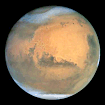
Mars is the fourth planet from the Sun.
The red planet Mars has inspired wild flights of imagination over the centuries, as well as intense scientific interest. Whether fancied to be the source of hostile invaders of Earth, the home of a dying civilization, or a rough-and-tumble mining colony of the future, Mars provides fertile ground for science fiction writers, based on seeds planted by centuries of scientific observations.
We know that Mars is a small rocky body once thought to be very Earth-like. Like the other "terrestrial" planets - Mercury, Venus, and Earth - its surface has been changed by volcanism, impacts from other bodies, movements of its crust, and atmospheric effects such as dust storms. It has polar ice caps that grow and recede with the change of seasons; areas of layered soils near the Martian poles suggest that the planet's climate has changed more than once, perhaps caused by a regular change in the planet's orbit. Martian tectonism - the formation and change of a planet's crust - differs from Earth's. Where Earth tectonics involve sliding plates that grind against each other or spread apart in the seafloors, Martian tectonics seem to be vertical, with hot lava pushing upwards through the crust to the surface. Periodically, great dust storms engulf the entire planet. The effects of these storms are dramatic, including giant dunes, wind streaks, and wind-carved features.
Jupiter

Jupiter is the fifth planet from the Sun.
The most massive planet in our solar system, with four planet-sized moons and many smaller moons, Jupiter forms a kind of miniature solar system. Jupiter resembles a star in composition. In fact, if it had been about eighty times more massive, it would have become a star rather than a planet.
On January 7, 1610, using his primitive telescope, astronomer Galileo Galilei saw four small 'stars' near Jupiter. He had discovered Jupiter's four largest moons, now called Io, Europa, Ganymede, and Callisto. Collectively, these four moons are known today as the Galilean satellites.
Galileo would be astonished at what we have learned about Jupiter and its moons in the past 30 years. Io is the most volcanically active body in our solar system. Ganymede is the largest planetary moon and is the only moon in the solar system known to have its own magnetic field. A liquid ocean may lie beneath the frozen crust of Europa. Icy oceans may also lie deep beneath the crusts of Callisto and Ganymede. In 2003 alone, astronomers discovered 23 new moons orbiting the giant planet, giving Jupiter a total moon count of 49 officially named -- the most in the solar system. The numerous small outer moons may be asteroids captured by the giant planet's gravity.
Saturn
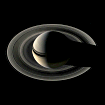
Saturn is the sixth planet from the Sun.
Saturn was the most distant of the five planets known to the ancients. In 1610, Italian astronomer Galileo Galilei was the first to gaze at Saturn through a telescope. To his surprise, he saw a pair of objects on either side of the planet. He sketched them as separate spheres and wrote that Saturn appeared to be triple-bodied. Continuing his observations over the next few years, Galileo drew the lateral bodies as arms or handles attached to Saturn. In 1659, Dutch astronomer Christiaan Huygens, using a more powerful telescope than Galileo's, proposed that Saturn was surrounded by a thin, flat ring. In 1675, Italian-born astronomer Jean-Dominique Cassini discovered a 'division' between what are now called the A and B rings. It is now known that the gravitational influence of Saturn's moon Mimas is responsible for the Cassini Division, which is 4,800 kilometers (3,000 miles) wide.
Like Jupiter, Saturn is made mostly of hydrogen and helium. Its volume is 755 times greater than that of Earth. Winds in the upper atmosphere reach 500 meters (1,600 feet) per second in the equatorial region. (In contrast, the strongest hurricane-force winds on Earth top out at about 110 meters, or 360 feet, per second.) These super-fast winds, combined with heat rising from within the planet's interior, cause the yellow and gold bands visible in the atmosphere.
Uranus

Uranus is the seventh planet from the Sun.
Once considered one of the blander-looking planets, Uranus has been revealed as a dynamic world with some of the brightest clouds in the outer solar system and 11 rings. The first planet found with the aid of a telescope, Uranus was discovered in 1781 by astronomer William Herschel. The seventh planet from the Sun is so distant that it takes 84 years to complete one orbit. Uranus, with no solid surface, is one of the gas giant planets (the others are Jupiter, Saturn, and Neptune).
The atmosphere of Uranus is composed primarily of hydrogen and helium, with a small amount of methane and traces of water and ammonia. Uranus gets its blue-green color from methane gas. Sunlight is reflected from Uranus' cloud tops, which lie beneath a layer of methane gas. As the reflected sunlight passes back through this layer, the methane gas absorbs the red portion of the light, allowing the blue portion to pass through, resulting in the blue-green color that we see. The planet's atmospheric details are very difficult to see in visible light. The bulk (80 per-cent or more) of the mass of Uranus is contained in an extended liquid core consisting primarily of 'icy' materials (water, methane, and ammonia), with higher-density material at depth.
Neptune
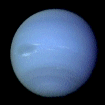
Neptune is the eighth planet from the Sun.
Neptune was the first planet located through mathematical predictions rather than through regular observations of the sky. (Galileo had recorded it as a fixed star during observations with his small telescope in 1612 and 1613.) When Uranus didn't travel exactly as astronomers expected it to, a French mathematician, Urbain Joseph Le Verrier, proposed the position and mass of another as yet unknown planet that could cause the observed changes to Uranus' orbit. After being ignored by French astronomers, Le Verrier sent his predictions to Johann Gottfried Galle at the Berlin Observatory, who found Neptune on his first night of searching in 1846. Seventeen days later, its largest moon, Triton, was also discovered.
Nearly 4.5 billion kilometers (2.8 billion miles) from the Sun, Neptune orbits the Sun once every 165 years. It is invisible to the naked eye because of its extreme distance from Earth. Interestingly, due to Pluto's unusual elliptical orbit, Neptune is actually the farthest planet (including dwarf planets) from the Sun for a 20-year period out of every 248 Earth years.

